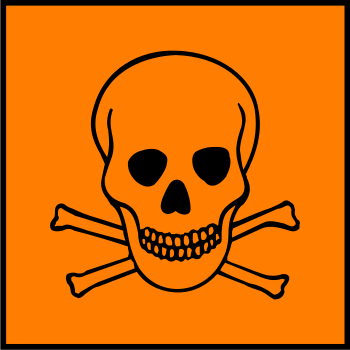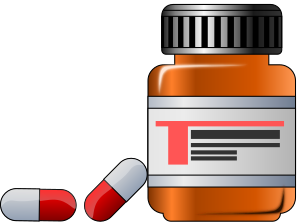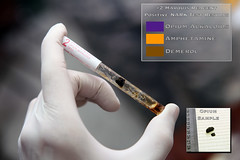______________________________________________________________________
| The hazard symbol for toxic/highly toxic substances. (Photo credit: Wikipedia) |
DISCLAIMER - This site is geared to help writers write it right. I am presenting information to help develop fictional characters and fictional scenes: this is for informational purposes only to be used for your fictional stories. The information is just a tiny bit about poisonous plants that is available. There is so much more that you can learn with a simple search. But this needs to be taken seriously, especially to protect your children and pets. These plants, while beautiful, are DEADLY, particularly to children and pets. Just licking some of these poisonous things can quickly CAUSE DEATH. Always check the toxicity of a plant before you add it to your
garden or home.
garden or home.
Growing Death in Your Garden
We all know the familiar nursery rhyme:
Mary, Mary quite contrary
How does your garden grow?
With silver bells, and cockle shells,
And pretty maids all in a row.
But do you know just how deadly little Mary’s garden really is? Cyanide was a particular favorite of Dame Agatha Christie. In her mystery And Then There Were None, the first death was from cyanide poisoning. And who can forget those lovely aunts from Arsenic and Old Lace, who used arsenic, cyanide and strychnine in the elderberry wine to kill their gentlemen callers? (I highly recommend you watch the movie with Cary Grant and Josephine Hull; it’s one of my favorite movies!) In the 1962 movie Dr. No, the cab driver, after a fight with James Bond, kills himself with cyanide in a cigarette rather than tell Bond who he worked for. But not all victims who use cyanide die. Such is the case with Raoul Silva from the 2012 James Bond movie Skyfall. Silva’s suicide attempt by hydrogen cyanide failed, and it burned his body internally, forcing him to wear a prosthetic face to hide the disfiguring injuries.
It was suggested to me that I use poison to kill off a character in my next novella, and I was shocked to discover just how toxic the plants are in flower and vegetable gardens. Take a look for yourself; I guarantee you will be totally surprised. I’m going to mention just a few in this article. I’ll talk about which parts of the plant are toxic, how toxic they are and the symptoms. At the end, you’ll find general treatment for these types of poison.
Water Hemlock/Spotted Parsley
Let’s start with what the USDA rates as “the most violently toxic plant that grows in North America”:
| English: Cowbane or Northern Water Hemlock (Cicuta virosa) a. (Photo credit: Wikipedia) |
Water Hemlock/Spotted Parsley (Latin name: cicuta maculata). It doesn’t look deadly, with its tiny white flowers and umbrella-like appearance. You’ll find it growing near the edges of your property in pastures
How toxic:
* CALL 911 or Poison Control at 1-800-222-1222.
Teresa -
Fiona-
Teresa -
I’m the daughter of a retired Methodist minister, so I moved a lot when I was a kid. Familiarity with small towns and the people in them have helped me with writing my stories. There are plenty of characters to draw from for inspiration! I’m a wife of a wonderful man, a mother to a hard-working, sweet, kind and caring 20-year-old son, a granddaughter to an awesome 95-year-old woman who is the basis for a character in my new series, a daughter to two wonderful people who have been so supportive, a sister to a few, and a friend to many.
Fiona -
and meadows.
Toxic parts of the plant:
Toxic parts of the plant:
The whole plant - especially the roots of early growth.
How toxic:
Deadly to take by mouth or to apply to the skin. Death occurs within a matter of minutes, depending on the dosage.
Symptoms:
Symptoms:
* The first symptoms include drooling, nausea, vomiting,
wheezing, sweating, dizziness, stomach pain, lethargy, and
delirium.
* More serious symptoms include trouble breathing, convulsions,
heart problems, kidney failure, coma, and death.
Foxglove (Latin name: Digitalis purpurea)
I’m sure you all recognize the word digitalis. Doctors use digitalis to strengthen the heart and regulate the heartbeat. The most commonly prescribed drugs are digitoxin and digoxin, and patients using these medications are carefully monitored by their doctors to make sure they suffer no ill effects. In your garden, they are tall, thin plants, with white, pink and purple bell-shaped flowers.
Toxic parts of the plant: the entire plant, especially the leaves of the upper stem.
How toxic:
Foxglove (Latin name: Digitalis purpurea)
| English: Foxglove Foxglove in hedgerow (Photo credit: Wikipedia) |
I’m sure you all recognize the word digitalis. Doctors use digitalis to strengthen the heart and regulate the heartbeat. The most commonly prescribed drugs are digitoxin and digoxin, and patients using these medications are carefully monitored by their doctors to make sure they suffer no ill effects. In your garden, they are tall, thin plants, with white, pink and purple bell-shaped flowers.
Toxic parts of the plant: the entire plant, especially the leaves of the upper stem.
How toxic:
As mentioned above, it is used for medical purposes. But, if you need a quick, effective way to kill off a character, a high dose of foxglove will effective dispose of them.
Symptoms:
Symptoms:
Blurred vision, confusion, depression, disorientation or hallucinations, fainting, headache, irregular or slow heartbeat, lethargy, loss of appetite, low blood pressure, rash or hives, stomach pain, vomiting, nausea or diarrhea, weakness or drowsiness.
(***Children have been known to die by sucking on part of the plant.)
Hydrangea (Latin name: hydrangea macrophylla)
My mother grows these in her garden in the front yard, and I think they are beautiful. They grow so big, and the flowers in colors of pink, blue or white are simply gorgeous (hers are blue). So I was shocked to discover that they are poisonous!
Toxic parts:
Hydrangea (Latin name: hydrangea macrophylla)
| Hydrangea macrophylla (Bigleaf Hydrangea, Hortensia) (Photo credit: Wikipedia) |
My mother grows these in her garden in the front yard, and I think they are beautiful. They grow so big, and the flowers in colors of pink, blue or white are simply gorgeous (hers are blue). So I was shocked to discover that they are poisonous!
Toxic parts:
The entire plant, especially the flower buds.
How toxic:
How toxic:
Think cyanide.
Symptoms:
Symptoms:
* Itchy skin, vomiting,
weakness, sweating.
* More serious symptoms
include shortness of breath,
dizziness, fainting, rapid pulse,
a drop in blood pressure that
can cause convulsions and death.
Mistletoe (Latin name: Phoradendron flavescens)
We all know what mistletoe looks like: a cluster of green leaves with white berries. A popular holiday decoration, all couples in love want to get caught standing under it for the kiss. But beware, looks can be deceiving, and enough mistletoe could give you the kiss of death.
Toxic parts:
Mistletoe (Latin name: Phoradendron flavescens)
| Mistletoe berries in Wye Valley (Photo credit: Wikipedia) |
We all know what mistletoe looks like: a cluster of green leaves with white berries. A popular holiday decoration, all couples in love want to get caught standing under it for the kiss. But beware, looks can be deceiving, and enough mistletoe could give you the kiss of death.
Toxic parts:
All of it, especially the berries.
How toxic:
How toxic:
It depends on the dosage. Drinking anything containing mistletoe, or munching on the leaves, berries or shoots will, at the very least, cause abdominal pain and diarrhea (I’ve never tried mistletoe tea, but apparently people do drink it.)
Symptoms:
Symptoms:
Stomach irritation, intestinal irritation, abdominal pain, diarrhea, reduced blood pressure, slowed pulse, nausea, vomiting, slowed heart rate, cardiovascular collapse, and seizures.
(***This is VERY potent for pets, so keep this away from them!)
Lily of the Valley (Latin name: Convellaria majalis)
How could something with a name that sounds like it should be in a song be so deadly? They are very sweet smelling, and look like tiny white bells.
Toxic parts:
Lily of the Valley (Latin name: Convellaria majalis)
| Convallaria majalis cv. Plena (Photo credit: Wikipedia) |
How could something with a name that sounds like it should be in a song be so deadly? They are very sweet smelling, and look like tiny white bells.
Toxic parts:
The entire plant, especially the leaves.
How toxic:
How toxic:
Even the water you put the flowers in will contain
deadly traces of toxins.
One bite will give you a
headache, hot flashes, hallucinations and irritability (sounds like menopause!). Enough of the toxins will slow your heart rate down, potentially leading to coma and even death.
Symptoms:
Symptoms:
Besides the ones mentioned above, symptoms could include abdominal pain, diarrhea, vomiting, nausea, confusion, fatigue, dizziness, and reduced blood pressure.
Nightshade (Latin name: Atropa belladonna)
Nightshade (Latin name: Atropa belladonna)
| Atropa belladonna or Atropa bella-donna, commonly known as Belladonna, Devil's Berries, Death Cherries or Deadly Nightshade (Solanaceae), Flower (Photo credit: Wikipedia) |
I've personally never seen
a nightshade plant, but I
have heard of belladonna. Mostly found overseas, it can now be found in North America, especially in areas rich with limestone. The berries are various colors of red, orange and green, and when they bloom, the flowers are purple with green pollen bulbs.
Toxic parts:
Toxic parts:
The whole plant, especially the berries, roots and leaves.
How toxic:
How toxic:
A single leaf can be fatal to an adult. You probably won’t even have time to call for help.
Symptoms:
Symptoms:
Unable to speak, respiratory problems, intense digestive distress, and violent convulsions.
Antidote/Treatment:
* CALL 911 or Poison Control at 1-800-222-1222.
* Try to find out how much poison the victim ingested and their
weight.
* DO NOT make the victim vomit unless instructed to by
emergency personnel.
An antidote depends on the type of poisoning, and with all the medical advances that are happening every day, an antidote could have been discovered as I write this. General treatment is aggressive supportive care by paramedics in the field, and then by hospital personnel. Depending on the severity of the poisoning, treatment could include:
* Activated charcoal
An antidote depends on the type of poisoning, and with all the medical advances that are happening every day, an antidote could have been discovered as I write this. General treatment is aggressive supportive care by paramedics in the field, and then by hospital personnel. Depending on the severity of the poisoning, treatment could include:
* Activated charcoal
* Gastric lavage
* Blood and urine tests
* Breathing support
* EKG
* Fluids
* Medication to treat specific symptoms.
Quick treatment improves your characters chances. But even then, the symptoms could last 2-3 days. The important thing is to get treatment for your victim as quickly as possible. But since this is for fictional writing, it might be better to let them die…
Fiona -
* Blood and urine tests
* Breathing support
* EKG
* Fluids
* Medication to treat specific symptoms.
Quick treatment improves your characters chances. But even then, the symptoms could last 2-3 days. The important thing is to get treatment for your victim as quickly as possible. But since this is for fictional writing, it might be better to let them die…
Fiona -
That was very interesting, Teresa. You put your research to work for you in your new Novella, can you tell us about your story?
Teresa -
It's time for the county fair, and things are heating up for the coveted "best pie" blue ribbon. But two competitors, Gladys Norwell, and Durlene Snodgrass, are disqualified the day before the fair.
During the pie eating contest, Gladys' husband, Harold, falls face first into his blueberry pie, and Gladys is the prime suspect. Did our beloved Gossip Queen kill her husband, or is someone setting her up? It's up to Lizzie, her beloved dogs Babe and Mittens, and the rest of the gang to
sniff out the truth before the Queen
is dethroned...permanently.
Fiona -
Fiona -
Very fun! You know here on ThrillWriting we always like to ask about the story behind your favorite scar. Would you share yours?
Teresa -
Known to my friends as Queen Klutz, my scars (and casts) are many, but the favorite scar story belongs to my son.
When he was 18 months old, he wanted juice one night before bedtime. I told him no, and went upstairs to get his pajamas. Alas, my son has his mother’s stubborn streak. The one time I had to buy a glass jar of juice was the time he decided to pick it up. I heard a crash, and came racing down the stairs. There was a trail of blood from the kitchen, across the living room, ending at my recliner, where my son sat on the floor. A bloody handprint was on the seat of the recliner. I grabbed the phone and a beach towel, wrapping it around his right hand as I called my parents. After I hung up, I looked at his feet, and noticed a pool of blood under his left foot. Another beach towel went around his foot.
Picking him up, I went outside, holding him in my arms while I waited for my parents to show up. When they did, my mother got out with tea towels and a box of Band-aids because she thought I was overreacting. When she saw me standing there with him in my arms, she immediately opened the back passenger door so I could get in. Three hours later, seven stitches in his hand, and five behind the toes of his foot, we were back home. The middle finger of his right hand is slightly bent because of scar tissue, and is a reminder of that night.
Fiona-
Before we end, could you tell us a little about you?
Teresa -
 |
| Teresa Watson |
Fiona -
Thank you so much, Teresa.














